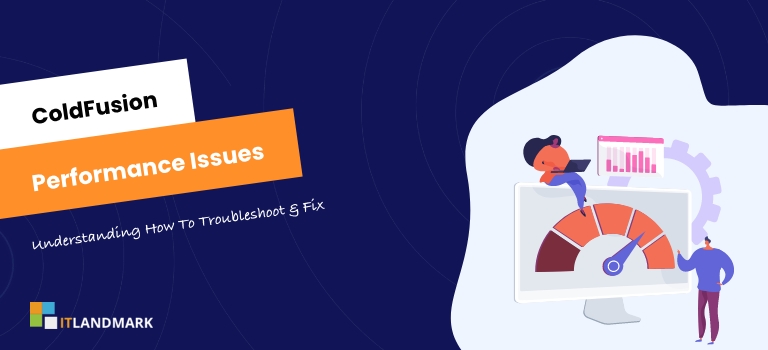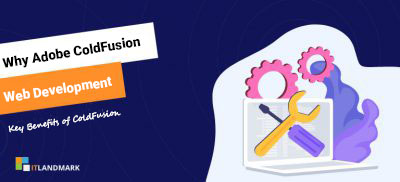
Are you seeking to enhance the performance of your ColdFusion applications? Look no further! ITLandmark is your trusted partner for maximizing the performance of your ColdFusion applications and providing top-tier ColdFusion Maintenance and Support. ITLandmark known for its best ColdFusion consulting services. In this guide, we will walk you through essential strategies to troubleshoot and resolve performance issues in your ColdFusion environment. You will learn how to analyze code effectively, optimize memory usage, fine-tune thread settings, and maximize caching options for better efficiency. With the right techniques and tools, identifying and addressing potential bottlenecks becomes simple. Unlock the full potential of your ColdFusion applications with ITLandmark!
Troubleshooting and Fixing ColdFusion Performance Issues
This in-depth troubleshooting guide equips you with the knowledge and techniques to identify, diagnose, and fix performance bottlenecks, ensuring seamless user interactions and optimal functionality.
1. Identifying the Performance Issue
Identifying the underlying cause of a slowdown is the first step in addressing any system deficiencies. To get to the root of the issue, it’s important to analyze metrics and profile performance for insights into what could be causing bottlenecks or hindering optimal usage.
- Monitor user reports and feedback: Gather information from users experiencing performance issues.
- Use application performance monitoring tools: Tools like FusionReactor, New Relic or AppDynamics can help identify slowdowns.
- Analyze response times and server logs: Look for patterns in response times and error logs to pinpoint issues.
- Identify peak usage times: Understand when the system experiences the most load to target performance improvements.
- Check the scheduled tasks: Review scheduled tasks to ensure they are not causing performance bottlenecks, especially during peak usage times.
Also Read: ColdFusion Performance Tuning Tips
2. Investigating the Root Cause
Investigating the root cause requires a rigorous review to reveal any relevant roadblocks.
- Isolate the issue: Determine if the problem is in the database, server configuration, or code.
- Analyze error logs: Look for error messages and stack traces that can provide clues.
- Reproduce the issue: Try to recreate the problem in a test environment to better understand it.
- Examine recent changes: Consider if recent updates or deployments could have introduced the issue.
- Monitor trends in usage metrics: To get to the bottom of ColdFusion performance issues, it is important for administrators and developers to monitor trends in usage metrics such as page load time or CPU utilization. This can provide invaluable data that needs to be analyzed carefully before taking further action.
3. Analyzing the CFML Code
Once you’ve identified the underlying issues, it’s time to analyze your CFML code and take proactive steps towards resolving them.
- Review for inefficiencies: Check for unnecessary complexity or poorly written code.
- Follow best practices: Ensure code adheres to performance best practices, such as avoiding unnecessary computations.
- Utilize debugging tools: ColdFusion offers built-in tools for debugging and profiling code.
- Check nested loops: Excessive nesting can significantly slow down performance; simplify where possible.
Now that we have taken a detailed look at how to analyze our CFML code, let’s move on to troubleshooting database queries which can often be one of the most complex tasks within ColdFusion development.
4. Troubleshooting Database Queries
- Use query profiling tools: Identify slow queries with tools like SQL Server Profiler or MySQL EXPLAIN.
- Optimize SQL queries: Refactor complex queries to be more efficient.
- Review database schema: Ensure tables are normalized and indexed appropriately.
- Implement indexing for possible columns: Add indexes to columns that are frequently used in WHERE clauses, JOINs, and ORDER BY operations to improve query performance.
- Implement database caching: Use database caching strategies to reduce load on the database.
Once these aspects have been addressed, we can move on to Examining Server Configuration and other measures to further enhance ColdFusion performance.
5. Examining Server Configuration
- Review settings: Check configuration files for optimal settings.
- Ensure adequate hardware: Verify that the server hardware is sufficient for the application’s needs.
- Check disk space and memory: Make sure there is enough available to prevent bottlenecks.
- Keep OS updated: Ensure the server’s operating system is patched and updated.
Optimizing memory usage is essential for achieving this goal; start now by making necessary adjustments in order to maximize efficiency going forward into the future.
6. Optimizing Memory Usage
- Monitor usage patterns: Identify memory usage trends and potential leaks.
- Adjust JVM heap size: Optimize heap size settings to balance memory use and garbage collection.
- Optimize ColdFusion settings: Adjust memory settings specific to ColdFusion.
- Reduce memory-intensive operations: Minimize operations that consume a lot of memory.
By taking these measures before adjusting thread settings, you’ll be able to get more out of your server without sacrificing stability or security levels.
7. Adjusting Thread Settings
- Review thread pool settings: Ensure settings align with server capabilities.
- Match threads to server capacity: Avoid overloading the server with too many threads.
- Balance parallel processing: Ensure optimal use of threads without causing contention.
- Monitor thread usage: Prevent deadlocks and resource starvation by adjusting as needed.
With this knowledge in hand, you can move on to minimizing garbage collection for further optimization.
8. Minimizing Garbage Collection
- Tune JVM parameters: Adjust settings for efficient garbage collection.
- Choose the right algorithm: Select a garbage collection algorithm that fits the application’s needs.
- Monitor GC logs: Analyze logs to identify and resolve GC-related issues.
- Minimize object creation: Reduce the number of objects created and destroyed to lower GC impact.
- Leverage caching: Caching plays an important role when it comes to reducing page load times by keeping data stored close to where it needs to be used most often – such as in the browser’s local cache – so it can be accessed quickly without having to make additional server requests each time a user visits a website or loads a new page.
Tuning ColdFusion caching can then provide further gains in speed and reliability for web applications going forward!
9. Tuning ColdFusion Caching
- Implement caching strategies: Use query, template, and object caching effectively.
- Use ColdFusion caching mechanisms: Leverage built-in options like Ehcache.
- Review and update cache strategies: Regularly adjust strategies based on application usage patterns.
- Clear and refresh caches: Prevent stale data by periodically refreshing caches.
By utilizing advanced Client-side caching techniques, server load can be further reduced and content delivery speeded up.
10. Leveraging Client-Side Caching
- Utilize HTTP headers: Control caching with headers like Cache-Control and Expires.
- Cache static resources: Implement caching for images, scripts, and other static files.
- Use CDNs: Offload resource delivery to content delivery networks.
- Set cache expiration policies: Ensure policies are appropriate for your content.
Having an accurate picture of what’s happening behind the scenes helps ensure that client-side caching is being used optimally so pages render quickly while still providing quality user experience. Armed with this knowledge administrators can work towards improving their overall site performance by implementing proper optimization procedures across the board –from server side settings down to the individual elements contained within each page request.
11. Optimizing Application Performance
- Conduct regular audits: Regularly review application performance.
- Optimize critical paths: Focus on improving high-traffic and critical areas of the application.
- Use asynchronous processing: Implement non-blocking operations to improve responsiveness.
- Monitor and fine-tune: Continuously observe and adjust performance metrics.
With a proactive approach towards optimizing your applications before problems arise, you’ll save valuable time and money spent on maintenance tasks later on down the road. Plus, who doesn’t want a scalable solution that offers improved reliability? Leveraging CFML features is another way developers can improve their app’s stability while simultaneously boosting its capabilities beyond what was previously thought possible.
12. Leveraging CFML Features
- Utilize built-in functions: Take advantage of ColdFusion’s built-in performance-enhancing functions.
- Explore caching options: Implement and optimize ColdFusion’s caching capabilities.
- Use ColdFusion components: Modularize code with CFCs for better performance.
- Implement asynchronous features: Leverage ColdFusion’s support for asynchronous processing
Enhancing performance typically requires an understanding of network connectivity; therefore it is important to assess any constraints before attempting further optimization.
13. Assessing Network Connectivity
- Monitor latency and bandwidth: Use tools to track network performance.
- Ensure infrastructure support: Verify that network infrastructure meets application needs.
- Diagnose issues: Troubleshoot and resolve network-related problems.
- Optimize data transfer: Implement efficient methods and protocols for data transfer.
By validating application security alongside these assessments of network components, you’ll have a better understanding of how everything fits together while uncovering opportunities for improvement across all layers within your system infrastructure.
14. Validating Application Security
- Perform security audits: Regularly check for vulnerabilities and security issues.
- Follow secure coding practices: Implement best practices for secure coding in CFML.
- Use secure protocols: Ensure communication uses secure protocols like HTTPS.
- Monitor threats: Continuously monitor for security threats and respond quickly.
Next step is to eliminate bad code practices that may lead to inefficient performance which could have an adverse effect overall system speed and responsiveness if left unchecked…
15. Eliminating Bad Code Practices
- Conduct code reviews: Regularly review code to identify and correct poor practices.
- Avoid anti-patterns: Educate the team on common anti-patterns and how to avoid them.
- Promote best practices: Encourage performance-friendly coding techniques.
- Use static analysis tools: Implement tools to detect bad practices and potential issues.
Now let us move onto analyzing log files for further insights into our ColdFusion application’s health!
Also Read: ColdFusion Functions
16. Analyzing Log Files
- Review logs regularly: Check application and server logs for errors and warnings.
- Use log aggregation tools: Implement tools for centralized log analysis.
- Identify performance trends: Use logs to spot trends and bottlenecks.
- Efficient logging practices: Ensure logging is thorough but does not degrade performance.
With these powerful tools at your disposal, improving efficiency and resolving issues faster than ever before has never been so easy!
17. Automating Performance Monitoring
- Deploy monitoring tools: Use automated tools and dashboards for performance tracking.
- Set up alerts: Configure alerts for performance thresholds and anomalies.
- Use APM solutions: Implement Application Performance Management tools.
- Track and report: Continuously monitor application health and report findings.
The next step towards maintaining optimal application performance is leveraging Load Balancing techniques which help distribute user requests among multiple web servers thereby reducing response time while increasing overall throughput across the network.
18. Leveraging Load Balancing
- Implement load balancers: Use to distribute traffic evenly across multiple servers.
- Monitor configurations: Regularly check and adjust load balancing settings.
- Ensure high availability: Implement failover and redundancy strategies.
- Optimize performance: Continuously tune load balancing for optimal performance.
The next step towards maintaining excellent ColdFusion performance involves stress testing your application in order to find potential weak points before they become costly issues down the line.
19. Stress Testing Your Application
- Conduct regular testing: Perform stress and load testing to understand limits.
- Use appropriate tools: Utilize tools like Apache JMeter, LoadRunner, or Gatling.
- Simulate peak conditions: Test the application under maximum expected load.
- Identify bottlenecks: Use test results to find and resolve performance issues.
Armed with real data from test runs, organizations can assess current infrastructure needs more accurately and plan ahead accordingly – making sure both customer satisfaction levels remain high and financial costs stay low.
Also Read: ColdFusion Frameworks
20. Upgrading Your Hardware
- Assess hardware capabilities: Regularly evaluate hardware performance.
- Upgrade as needed: Enhance servers, storage, or network infrastructure to meet demands.
- Match application requirements: Ensure hardware scales with application growth.
- Monitor performance: Keep track of hardware performance metrics.
Utilizing Cloud Computing provides many benefits that are worth investigating further if you’re looking to improve the performance of your application.
21. Utilizing Cloud Computing
- Leverage cloud services: Use cloud infrastructure for scalability and flexibility.
- Implement auto-scaling: Automatically adjust resources based on demand.
- Use cloud-based solutions: Employ services like AWS, Azure, or Google Cloud.
- Monitor costs: Keep an eye on resource usage and costs in the cloud.
22. Utilizing Enterprise Solutions
- Explore performance management tools: Implement enterprise-level tools for performance monitoring.
- Use enterprise solutions: Leverage robust solutions for database and application performance.
- Consult enterprise support: Utilize enterprise support and consulting services.
- Integrate with existing systems: Enhance performance by integrating with enterprise systems.
By taking advantage of the various benefits offered by enterprise solutions in conjunction with more traditional methods for troubleshooting ColdFusion performance issues, organizations can ensure their applications remain up-to-date and running smoothly over time – leading to higher customer satisfaction rates and improved user experience all around.
23. Leveraging Third-Party Services
- Use APIs and services: Offload processing tasks to third-party services.
- Evaluate tools: Choose performance-enhancing third-party tools.
- Ensure reliability: Select services that meet performance and reliability standards.
- Optimize usage: Regularly review and optimize how third-party services are used.
Next, we’ll look at how outsourcing performance tuning tasks can further improve results.
24. Outsourcing Performance Tuning
- Engage experts: Hire performance tuning experts or consultants.
- Outsource specific tasks: Delegate specific optimization tasks to external experts.
- Utilize external audits: Get unbiased evaluations through external audits.
- Align with needs: Ensure outsourced services meet application requirements and standards.
However, careful consideration must be given to each component involved in the decision making process prior to taking action if maximum benefits are going to be realized from this strategy.
25. Establishing Performance Baselines
- Define benchmarks: Set performance benchmarks and goals.
- Measure regularly: Compare current performance against established baselines.
- Identify changes: Use baselines to detect performance degradation or improvements.
- Update baselines: Regularly adjust baselines to reflect changes in application requirements.
By understanding exactly what needs improvement before beginning any project related to ColdFusion performance tuning, you’ll not only save valuable development time but also maximize your ROI (Return On Investment).
Establishing clear-cut objectives beforehand helps ensure success down the road while avoiding costly trial-and-error mistakes which could potentially derail an entire initiative from achieving its desired outcome.
Frequently Asked Questions
What is the best way to optimize memory usage for ColdFusion?
Optimizing memory usage for ColdFusion can be a daunting task, however with the right tools and techniques you can easily improve your application’s performance. CFMonitoring, Debugging Tips, Memory Leaks, Query Optimization and Profiling Tools are all key components in this process. Utilizing these features to their fullest potential will not only help identify issues but also provide useful information on how to avoid them in the future.
Additionally, utilizing CFScripting and Performance Tuning is an effective way to reduce memory leaks that could occur due to poor management. By taking advantage of these powerful tools you can ensure that your applications run efficiently without sacrificing quality or wasting resources. With a little effort and knowledge, you can unlock the power of innovation through efficient ColdFusion memory management.
What steps should I take to improve the performance of my ColdFusion application?
You want to get the most out of your ColdFusion application and ensure it runs efficiently? Then you need to take a few steps. Start by optimizing queries, debugging issues, profiling the environment and analyzing behavior. Next up is optimizing resources, caching data and testing performance. Finally, don’t forget about troubleshooting bugs – this is essential for long-term success. By following these steps, you’ll be able to maximize efficiency in your ColdFusion application and reap all its benefits!
How can I ensure that my ColdFusion code is secure?
You need to take steps to secure your ColdFusion code, and you can do this by following best practices for secure coding. Make sure that you are properly managing access to databases as well as using event logging and error handling. You should also optimize queries and limit resources used, use compression techniques where possible, and implement a good caching strategy. By taking these measures, you’ll ensure that your ColdFusion application is performing securely at its highest level of efficiency.
Is it possible to automate performance monitoring in ColdFusion?
Are you looking to automate performance monitoring in ColdFusion? You’re not alone! With so many variables that contribute to the success of an application, such as data gathering, thread tuning, server tuning, error logging and debugging issues, it can be difficult to keep track of them all.
Luckily there are a variety of tools available to help you streamline your process including coding standards, performance tuning and monitoring tools. Embrace innovation with these resources at your fingertips and ensure that your applications run optimally without taking too much time out of your day.
What hardware upgrades should I consider to maximize ColdFusion performance?
If you’re looking to maximize ColdFusion performance, there are a few hardware upgrades to consider. Virtualization and clustered servers can provide fault-tolerant, load balancing capabilities while server tuning, disk optimization, database indexing and multi-threading allow for further performance gains. With the right combination of these technologies, you’ll be able to achieve maximum efficiency for your ColdFusion application. Investing in reliable hardware is essential for any organization that wants to stay ahead of the competition with their digital solutions.
Conclusion
You have all the tools you need to troubleshoot and fix ColdFusion performance issues.
Armed with an arsenal of strategies, from optimizing memory usage and CFML caching, to leveraging client-side caching and stress testing your application, you’ll be prepared to tackle any issue that comes your way!
And with a keen eye for detail, comprehensive understanding of server configuration and network connectivity, as well as careful analysis of code practices and log files, you can ensure optimal performance in no time.



